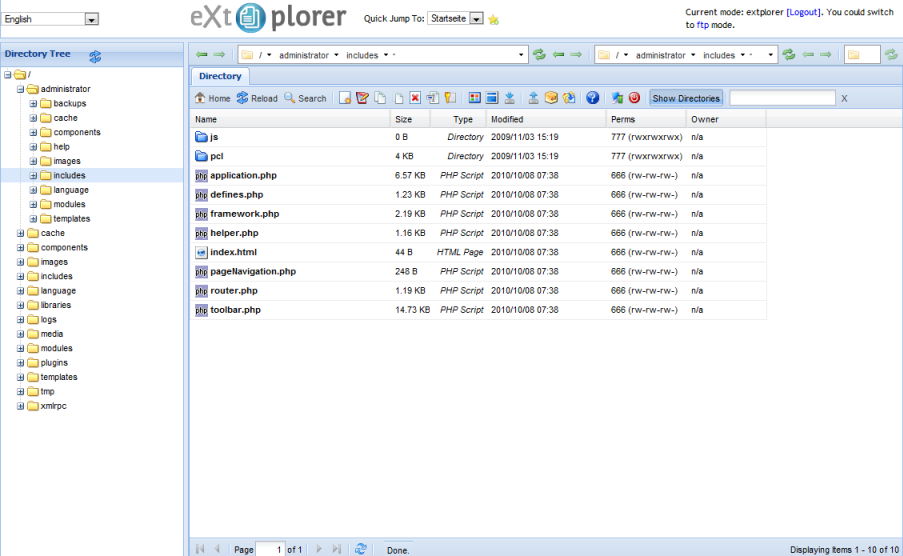File Manager The File Manager allows you to upload, create, rename, or delete files, organize files in folders, extract archives, and change file permissions. The file manager has almost all features you might need from an FTP program. To open and navigate in the File Manager: 1.
Get 292 file manager PHP scripts on CodeCanyon. Buy file manager PHP scripts from $6. Windows 7 Pro Oa Hp Iso. All from our global community of web developers.

Click on the File Manager button on the home page. Navigate by using the following: - Open a folder by clicking on the folder icon or on the folder name - Go up a level by clicking on the Up one level link '. Xerox Workcentre Pe114e Drivers. ' Creating a new folder Folders are very useful to keep your site structure and files organized. They make the maintenance of the site much easier. For example, you can use a folder named 'images' to store all of your image files and keep them separate from the HTML ones.
To create a folder you need to navigate to the parent folder you want to create it. Then specify the name of the new folder at the ' Create directory' box and click the Create dir button.
Uploading file/files in File Manager You can use the File Manager to upload files to your web site. You can upload both a single file or several files at a time, up to 10 files at once. To upload files you first need to: 1. Navigate to the folder you want to upload them to.
- To upload a single file, scroll down to the bottom of the file list and click on the Browse button next to the Upload File: field. Search for and double-click the file you'd like to upload from your local computer and then click on the Upload button.
The upload will start and when it is finished, the screen will refresh and your new file should show up in the file list. - To upload multiple files, use the same procedure, but instead of double-clicking one file, select all the files you wish to upload from a folder on your computer and confirm. The maximum number of files that can be uploaded at once is 20.
Creating a new file For text files sometimes it can be easier to create them online, rather than on your home computer and then uploading the file. You can create text files, such as HTML, Perl, PHP, or any other plain text files, including.htaccess and.htpasswd files in case you need such. 2230ij Engineering Printer Driver. To create a new file: 1. Navigate to the folder where you want to create your text file. Scroll down to the bottom of the file list and enter the name of the new file in the Create file: field. College Physics Paul Peter Urone Pdf Printer. You need to add the file extension to the name, for example script.php or index.html, not just script or index.
Click on the Create File button. The screen will refresh and the newly created file should show up in the file/folder list. Editing a file The File Manager allows you to make changes to your web site anywhere, without having to use some HTML program on your local computer and then upload the new version of the file to the server. To edit a file: 1. Navigate to the folder where the file is located.
Click on the name of the text file. You will be taken to a screen where you will be able to edit the contents of the file. Change the file as needed. Click on the Save button to save the file, but stay in Edit mode. Click on the Save and Exit when you have finished with the changes. The file will be saved and any changes will be updated. Click on the Exit button to exit the Editor without saving any changes made to the file.
Renaming a file or folder The file manager allows you to change the name of a file or folder. To rename a file or folder: 1. Navigate to the file or folder. Click the button for the file or folder and enter the new name. Then click the button. Changing file/folder permissions All files on UNIX (including Linux and other UNIX variations) machines have file system access permissions.
These tell the operating system how to deal with requests to access these files. Here you can find how to set file permissions for some of the most common web files and folders: pages, Perl and PHP scripts and data/config files, images and folders.
[>img[extplorer_tn.png][extplorer.png]]'eXtplorer' is a web-based File Manager. You can use it to * browse directories & files on the server and * edit, copy, move, delete files, * search, upload and download files, * create and extract archives, * create new files and directories, * change file permissions (chmod) and much more. You can even use eXtplorer to login to the FTP server (like [[net2ftp and work as if you were using an FTP client. Access via ~WebDAV is also possible (requires some extra work and a database!). EXtplorer is released under a dual-license: You can choose wether you want to use eXtplorer under the [[Mozilla Public License (MPL 1.1) or under the [[GNU General Public License (GNU/GPL).